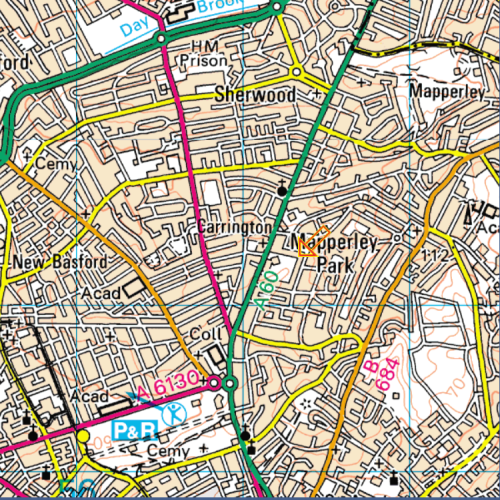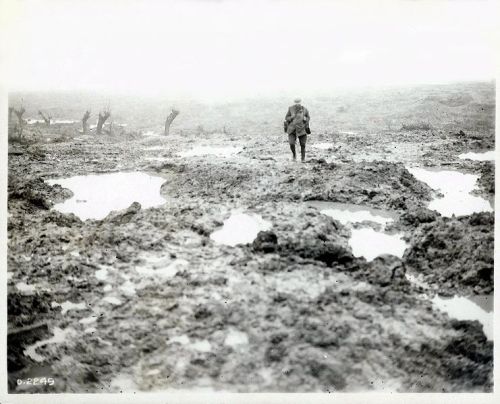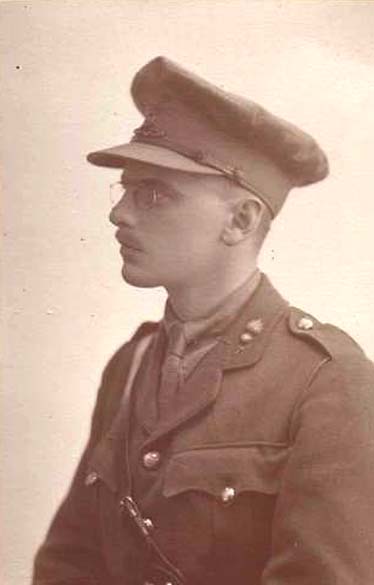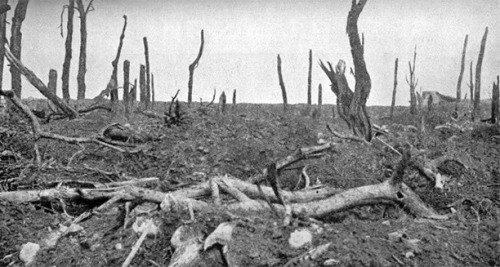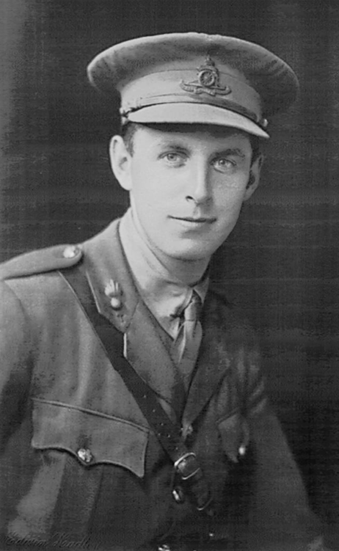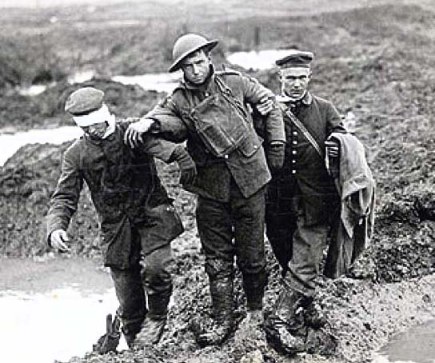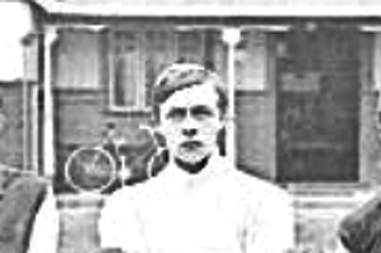The very first game of Rugby in the long history of the High School was played on Friday, December 26th 1913, the last Christmas and the last Boxing Day before the outbreak of the Great War. The game took place on the High School’s playing fields at Mapperley Park Sports Ground , used by the school since 1897, when they had left the Forest Recreation Ground which was considered to be too dangerous for boys to play sport there.
This map shows the walk from the High School (which is in the bottom left on the opposite side of the yellow road from the “C” of “Cemy”) down to Mapperley Park in the centre right, indicated by the orange arrow. The present day Games Field, at Valley Road, is the blue word “Day” in the top left hand corner.
This map shows the site of the Sports Ground in greater detail. Look for the orange arrow again.
This is the Pavilion at the Mapperley Park Sports Ground which was demolished only within the last twenty or thirty years . The young men are a long forgotten First XI school cricket team from just a few short years before the Great War.
 The gentleman on the left of the back row is Mr.Albert Grant Onion, the groundsman. He coached the High School cricketers with great enthusiasm, and saw many of them go on to do very well with local clubs. In 25 years, he did not miss umpiring a single 1st XI fixture, and was famed for his fairness and impartiality. He and his wife and daughters were responsible, too, for preparing all of the teas for the players. The young man at the other end of the back row is probably the team scorer, who kept an exact record of the game. Alternatively, he may be the reserve player, the so-called twelfth man.
The gentleman on the left of the back row is Mr.Albert Grant Onion, the groundsman. He coached the High School cricketers with great enthusiasm, and saw many of them go on to do very well with local clubs. In 25 years, he did not miss umpiring a single 1st XI fixture, and was famed for his fairness and impartiality. He and his wife and daughters were responsible, too, for preparing all of the teas for the players. The young man at the other end of the back row is probably the team scorer, who kept an exact record of the game. Alternatively, he may be the reserve player, the so-called twelfth man.
On this occasion though, on Boxing Day, 1913, it was not a cricket match but a rugby game. As a preliminary before the school’s changeover from Football, which was played from 1870-1914, to the new sport of Rugby Union, therefore, the Old Nottinghamians played against Notts Rugby F.C.. The Old Boys lost a closely fought game by (three tries) 9 points to (three goals), 15 points. The tries were scored by H.A.Johnstone, C.G.Boyd and D.P.C.Grant. The referee was Mr.Lionel Kirk. Presumably, this fixture served for many people as a demonstration of the new sport. In the days before television, the majority of Old Boys and Masters, and especially the parents and current pupils, would probably never have seen the game played before.
The Old Boys’ team was Stocks; H.A.Johnstone, H.S.Stocks (Captain), A.Willatt, R.L.W.Herrick, C.G.Boyd, W.Johnstone; D.P.C.Grant, F.Hardwick, J.K.Turpin, A.R.S.Grant, H.W.Ballamy, L.W.Peck, E.G.Hogan and W.S.Facon.
A pleasant interval in the Christmas festivities, one might think, a little respite from a surfeit of roast turkey, brussels sprouts, Christmas pudding, port, sherry, cigars and all the other indulgences of this wonderful time of year. Except that nobody who was there on that fatal Friday knew that a World War was to break out within less than eight months. That more than four years of fighting would leave almost a million British dead, and in that number would be more than three hundred Old Nottinghamians.
In actual fact, the eventual fate of the members of the Old Boys’ Rugby team pretty much defies belief. As well-intentioned, patriotic, decent, optimistic, courageous and athletic young men, they were to run forward into the maelstrom of the Great War as if it were a blood spattered combine harvester.
Henry Archer Johnstone became a Major in the 152nd Brigade of the Royal Field Artillery. He was the beloved son of John and Ada Johnstone, of Fairmead, Risley, Derbyshire.
Henry was to die on Tuesday, May 21st 1918, at the age of only twenty eight. He is buried in Wancourt British Cemetery near Arras in northern France. His rugby playing days were finally over.
H.S.Stocks, who left the High School in July 1904, was eventually to become a Lieutenant in the 7th (Service) Battalion of the Royal Sussex Regiment. He was severely wounded on Friday, July 7th 1916, in the Battle of the Somme, and rendered unfit for further active service. I would certainly have been very surprised if he ever played any more Rugby matches with his young laughing friends.
John Riversdale Warren Herrick was a Captain in the “2nd King Edward’s Own Gurkha Rifles (The Sirmoor Rifles). He was in the 3rd Battalion attached to the 11th Gurkha Rifles when he was fatally wounded on active service in Iraq. The son of Dr.R.W.Herrick and Mrs.Edith Herrick of 30, Regent Street, Nottingham, Captain Herrick was to die from his wounds on Sunday, October 24th 1920 at the age of only twenty seven. He is buried in the Basra War Cemetery, Iraq. His rugby playing days were finally over.
Charles Gordon Boyd was a Second Lieutenant in the 7th Battalion of the Sherwood Foresters, but was attached to the 9th Battalion of the Leicestershire Regiment. On Thursday, May 3rd 1917, he was killed whilst attacking Fontaine-Les-Croiselles with ‘D’ Company at the age of only twenty four. He was the son of George Herbert Boyd and Sarah Louisa Boyd, of, initially, 13, Tavistock Drive, Mapperley Park. Charles Boyd had been the Captain of the School in 1911-1912. In cricket, he was the First Team’s wicketkeeper and he was an enthusiastic footballer who played regularly for the First Eleven. His full record as a goalscorer was eleven goals in nine appearances. He surely got changed for this particular fixture in his own home nearby and perhaps walked along Tavistock Drive to the pitch in a laughing little group of his fellow players. At the time of his death, his parents had moved to St Peter’s-in-Thanet, Kent. Tragically, Charles Boyd’s remains were not found until some six years after his death, in November 1923, when he was reburied in the Heninel-Croisilles Road Cemetery in the Pas-de-Calais in northern France. His rugby playing days were finally over.
James Knowles Turpin was the beloved only son of Harry and Minnie Turpin, of 68, Henry Road, West Bridgford. James was a Second Lieutenant in “A” Battery, 241st South Midland Brigade of the Royal Field Artillery.
On Tuesday, August 14th 1917, he was killed in action at Boundary Road behind the Brigade HQ at Hill Top Farm near St Jaan just west of the frontline. he was just twenty five years of age. He was buried in Plot 6, Row D, Grave 7 in Vlamertinghe New Military Cemetery, West-Vlaanderen, Belgium. His rugby playing days were finally over.
Allan Roy Stewart Grant, while he was at school as A.R.S.Grant, was nicknamed “Pongy” by his fellow students, because of his parents’ choice of initials for him. He served as a Captain in the 10th Battalion of the Seaforth Highlanders, Ross-shire, Buffs, and the Duke of Albany’s. He was awarded the Military Cross. “Pongy” survived the conflict and duly returned to Nottingham.
Not so his elder brother, Donald Patrick Clarke Grant, who was in the 7th Battalion of the Cameron Highlanders. He is listed as either a Lance-Corporal (by the Commonwealth War Graves Commission), or a Lieutenant (in the school lists of the fallen). He was killed on Thursday, April 12th 1917 at the age of only twenty seven. He had previously been the Manager at the British Crown Insurance Office in Nottingham. His remains were never found but his death is commemorated on the Arras Memorial.
Both young men were the beloved sons of the Reverend John Charles Grant, a Minister of Religion, and his wife Ellen Jemima Grant who lived at “The Manse” at 16, Baker Street, Nottingham. The family was of Scottish origin. Donald had, in actual fact, been born at Loanhead in Midlothian.
Harold William Ballamy was a Lieutenant in “B” Battery of the 231st Brigade of the Royal Field Artillery.
He was the beloved son of Frederick William Ballamy, a commercial traveller, and his mother, Mrs.M.A.Ballamy of 17a, Gedling Grove.
He was killed on either Tuesday, August 14th or Wednesday, August 15th 1917, as part of the Third Battle of Ypres, usually known as the Battle of Passchendaele. He was twenty four years of age, and is buried in Fosse No 10 in the Communal Cemetery Extension at Sains-en-Gohelle, in the Pas-de-Calais in northern France. His rugby playing days were finally over.
Leslie Wayland Peck was the son of Thomas Wayland Peck, a Clerk in Holy Orders, and a Diocesan Inspector of Schools, who had been, from 1885-1900, a master at the High School. From 1886-1893, despite being a teacher, Peck Senior had played regularly for the school’s First Team at both football and cricket. The family lived initially at 12, Arboretum Street, Nottingham, and then in Gedling Grove. He must certainly have known Harold Ballamy, a near neighbour. Perhaps the two boys used to make the short walk to school every morning, accompanied by Mr Peck. What could have been more embarrassing than walking to school with one of the teachers? Fortunately it was a very short walk. Today it would just necessitate crossing over the tram lines at the High School tram stop.
Leslie Peck left the High School in June 1910, and joined the Bank, an establishment which was later to change its name to the National Westminster Bank. He had already served in the School Cadet Corps under Captain Trotman, and then joined the Sherwood Foresters Special Reserve. He was called up, and sent to France quite early in the Great War. He was “Mentioned in Dispatches”, but after being extremely badly shell-shocked, was invalided back home for a period of hospital treatment.
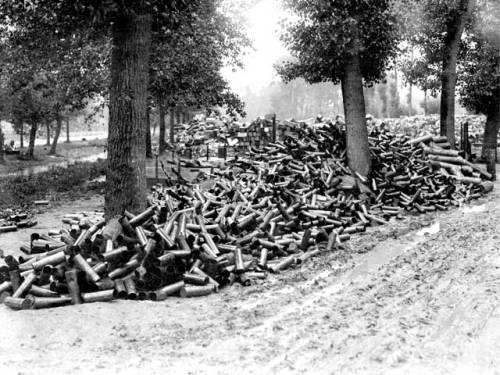 Leslie was then posted back to the Sherwood Foresters, but was never well enough to serve overseas again. I would certainly have been very surprised if he ever played any more Rugby matches with his young laughing friends.
Leslie was then posted back to the Sherwood Foresters, but was never well enough to serve overseas again. I would certainly have been very surprised if he ever played any more Rugby matches with his young laughing friends.
M.J.Hogan was the school goalkeeper from 1903-1905. In the Great War he became a Sergeant in the 1st Battalion of the Grenadier Guards. He was severely wounded on an unknown date. His goalkeeping days, and his rugby playing days too, were probably over for ever.
I have been unable to trace anything concrete for W.S.Facon although according to the London Gazette, a Lieutenant W.S.Facon was promoted to Captain on December 21st 1921. The Internet also reveals that in the Air Force List for May 1939, a W.S.Facon worked at the Air Ministry in the Department of the Permanent Under-Secretary in the Directorate of Contracts.
I have been unable to trace either how many of these keen pioneer rugby players had been in the Officer Training Corps, but however many it was, it certainly had not trained them well enough for the Somme (1916) or Passchendaele (1917)

